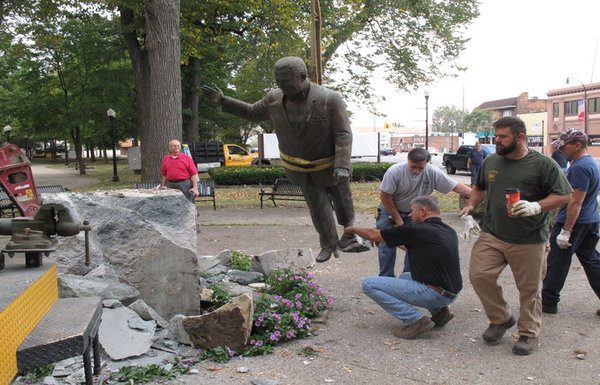
|
| The corner of Brady and Garrison, where the statue will be placed |
DEARBORN — The statue of late Dearborn Mayor Orville Hubbard will be placed in front of the Dearborn Historical Museum, according to city sources.
Hubbard, mayor from 1942 to 1978, was a vocal proponent of racial segregation.
His statue stood in front of Dearborn’s historic city hall from 1989 until it was removed in September.
Residents and civil rights organizations had requested removing the monument, equating it to the confederate flag as a symbol of racism.
But Jack Tate, the curator of the Dearborn Historical Museum, said the statue was moved from the former city hall simply because it was no longer city property.
The Dearborn municipal government sold City Hall to Artspace and moved to a new administrative center farther west on Michigan Avenue. The historical building is being turned into lofts and studios for artists.
Tate confirmed that the statue will be placed in front of the DHM, facing Brady Street.
“We knew it was going to be moved a year ago,” he told The Arab American News.
Tate said the media coverage of relocating the statue was “way overblown.”
“Mayor Hubbard was a politician of his time,” Tate said. “He was not different than other politicians in that era. He is a significant part of the history of Dearborn.”
David Good, Hubbard’s biographer and a member of the Dearborn Historical Commission, said the mayor’s office recommended the new location of the statue, and the commission approved it unanimously.
He added that there is no place for the monument inside the museum.
“I think outside the museum is a pretty good spot,” Good said. “I endorse that.”
However, he added that he would have liked the statue to be displayed at the Henry Ford Museum, as a part of the civil rights era exhibit.
“I did make that suggestion to the administration,” Good told The Arab American News. “I believe Orville Hubbard would have loved a place like that, where he could be seen up close and personal by thousands of people. It would have enabled people to know what he thought about segregation. He was not ashamed of it.”
Good said he understands why people oppose the statue and he is glad it is no longer at City Hall.
“In a way, Hubbard was a symbol of racial segregation, but not to the extent of the Confederate flag,” he said. “He belongs in the Historical Museum.”
Hubbard made anti-Black statements and tried to discourage African Americans from moving to Dearborn.
He openly used the n-word. During the Detroit riots of 1967, he ordered the police to shoot looters on sight.
He gained national fame for his views and became known as the North’s last segregationist.
“Goddammit. I don’t hate niggers. Christ, I don’t even dislike them. But if whites don’t want to live with niggers, they sure as hell don’t have to. Dammit, this is a free country. This is America,” Hubbard told the New York Times in 1969.
However, according to Good, Hubbard did not perceive himself as racist.
“Orville Hubbard was a very complicated person,” Good explained. “Segregationist is what he called himself. He did not want to be called racist because the dictionary definition of a racist, at least at that time, was a person who thought Blacks were inferior to Whites. Hubbard thought that races should not be forced to live together. That was his position.”
Despite his tainted legacy, Hubbard is credited for improving the quality of life in Dearborn. The late mayor commissioned the purchase of Camp Dearborn and bought homes for the city’s senior citizens in Florida.
“But it needs to be pointed out that the reason he was able to provide these services is the tax money of Ford Motor Company,” Good said.
He added that despite his social conservatism, Hubbard was somewhat socialist by providing ample city-sponsored services.
The debate over Hubbard’s statue reignited after the Charleston shooting. On June, 29, journalist Bill McGraw published an article in Deadline Detroit, suggesting moving the statue to the Historical Museum.
In the following weeks, other media outlets, including this newspaper, asked if the monument should be removed.
The Arab American Anti-Descrimination Committee (ADC) called for taking down the statue.
“We understand that Hubbard and his statue are aspects of our city’s history, but that is exactly what they need to be viewed as — history — which is not always without shame,” ADC-Michigan director Fatina Abdrabboh wrote in a column for the Free Press on July 3.
Placing the statue outside, not inside, the museum, may be unsatisfactory for those who advocated for removing it from City Hall.
Before the statue was moved, a plaque below it described the late mayor as an “effective administrator,” without mentioning his history of promoting segregation.
Tate, the curator, said the museum will be responsible for the new plaque, but the city’s administration has to approve it.






Leave a Reply